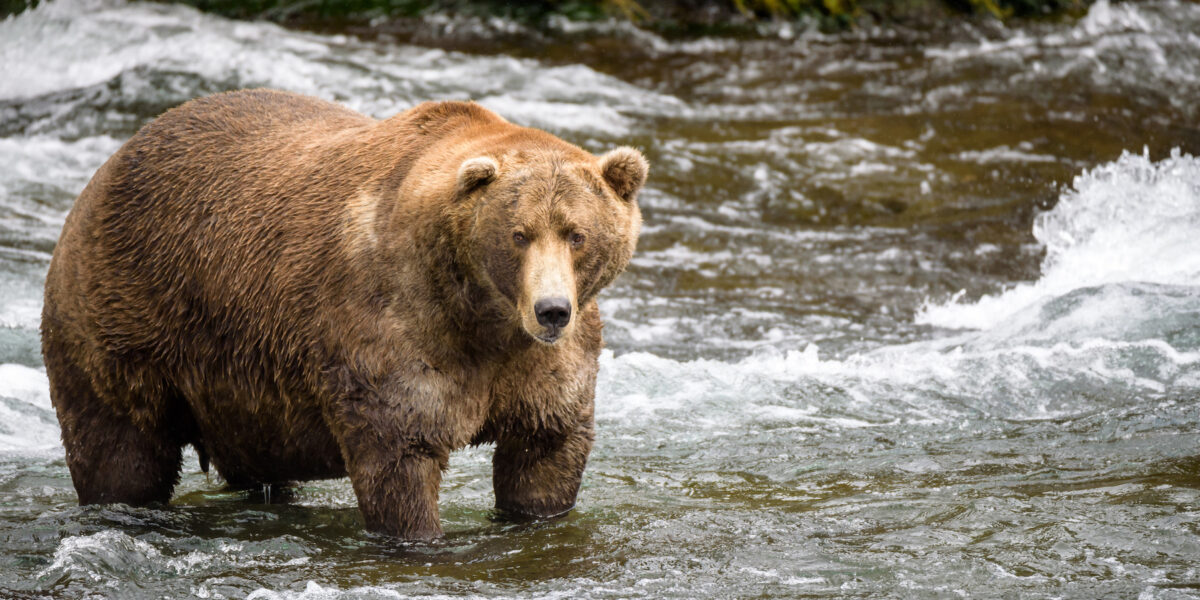
Fat Bear Week Is Here. Who Will Be the King (or Queen) of Katmai National Park?
The annual competition based out of Alaska’s Katmai National Park has begun.

Getty Images
Last week, Congress was almost the bearer of bad news. Fat Bear Week, the beloved annual contest for Alaska’s chunkiest brown bear put on by the National Park Service, would’ve been among many federal programs canceled if the government had shut down.
At the time, NPS told news outlets “hopefully” Fat Bear Week wouldn’t be postponed. After all, it’s a highly anticipated event: Current rangers said the bracket-style internet competition has grown wildly in popularity since it started in 2014 as a single-day contest. Last year saw more than one million votes cast.
But in Washington, D.C., as in Katmai National Park, anything can happen. At the last minute, Congress averted a shutdown, which means it ain’t over until the fat bear wins. (The competition started on October 4, and winners will be announced on October 10.)
Mike Fitz, the former park ranger who started Fat Bear Week, said part of the draw is that no two competitions are the same.
“Every year is unique at Brooks River,” the Explore.org naturalist said in an interview. “Every year has one or more special stories to tell.”
Some years see rookie bears enter the competition, challenging the prowess of past years’ winners who return for another claim to the heavyweight title. Some years, there are mothers with cubs—adopted or biological. In 2019, the sockeye salmon population ballooned and a smorgasbord of fish brought out behaviors in bears that would’ve been subverted by instincts for food competition. During the COVID-19 pandemic, Fitz recalls viewership spiked as people were housebound, perhaps looking for a proverbial breath of fresh air.
“Last year, we saw two mother bears—sisters—basically become an integrated family with their own cubs,” Fitz said. “They traveled together, they fished together, they played together, they rested together, they let their cubs take fish from everyone. It was behavior that we had never seen between two mother bears before.”
Regardless of who wins, rangers are just happy to see bulkiness across the board.

Getty Images/Sarkophoto
“Bear fat equals success,” said Felicia Jimenez, an interpretive ranger at Katmai. “Gaining those critical fat reserves is super, super important. Bears, when they enter the den for hibernation, they don’t eat, they don’t drink, they don’t defecate or urinate. They’re purely living off of those fat reserves. And during that time, when they’re in hibernation, when they come out of the den, they can lose up to a third of their body weight. So gaining that weight is very, very critical, and gaining enough fat is very high stakes for them.”
The average adult male bear weighs, on average, 700 – 900 pounds in mid-summer. By early fall, the biggest males can weigh more than 1,200 pounds.
Including bears of various sexes, ages and maturity in the bracket helps the public understand the different strategies they use to pack on the pounds, Jimenez said. That’s part of what goes into selecting the bears.
The other part is getting the bears on camera, a huge part of the preparation.
“I think people don’t realize like how much work really goes into photographing the bears,” Jimenez said. “They see these pictures and they’re like, ‘Oh, I wish they thought about a different angle’ or ‘Oh, I wish it was like a better and more flattering picture.’ And it’s like, I have been watching this bear every time I go out on the river for a month, and this is the first time this bear has gotten out of the water.”

Getty Images
Jimenez’s camera roll grows into the thousands to get the winning shot.
“Sometimes you get really lucky and the bears want to photograph for you,” she said.
Bears come out of hibernation in spring, and that’s when rangers take photos of them at their skinniest. Then, through summer and early fall, bears feast at Brooks River, one of the last healthy sockeye salmon runs on the planet, and can eat 80 to 90 pounds of food per day.
“The bears are the stars, but I think the true unsung heroes of Fat Bear Week are the sockeye salmon,” Jimenez said. “Without the salmon, there would be no fat bears.”
Then, rangers take “after” photos to capture their transformations. Since the bears can’t be picked up and put on a scale, rangers have experimented with non-invasive scanning technology to gauge weight gain.
Here’s who to keep an eye out for this year:
- Jimenez said she loved 901, a medium-sized mama bear with blond-rimmed, triangular ears, who was a newcomer last year and lumbered into second place.
- Otis is a perennial favorite that always has a satisfying, dramatic transformation to rotundity, “despite the difficulties and rigors of old age,” Fitz said.
- Holly, who resembles “a lightly toasted marshmallow,” is the 2019 champ who successfully reared a mixed brood of biological and adopted cubs with their fair share of now-healed injuries. This season, however, the maternal mammoth returned as a bachelorette and could give birth to a litter in hibernation.
No matter the outcome, the bears capture the hearts and screens of those who follow them, and for Fitz and Jimenez, watching those bonds form reminds them of something they and other rangers and conservationists know all too well: everything is linked.
“The connections that people make to the bears through the webcams are every bit as strong as the connections that people make when they physically visit Katmai,” Fitz said. “The bear cams have created stewards for Katmai among people around the world.”
In turn, the attention from the public has helped tracked things rangers don’t see, like a missing cub or an injured bear.
“Collectively, there are people watching from around the world at all hours, so virtually nothing escapes someone’s attention,” Fitz said. “The amount of knowledge that we’re gaining and gathering about these individual bears is quite amazing.”
This story originally appeared on Federal Times.
